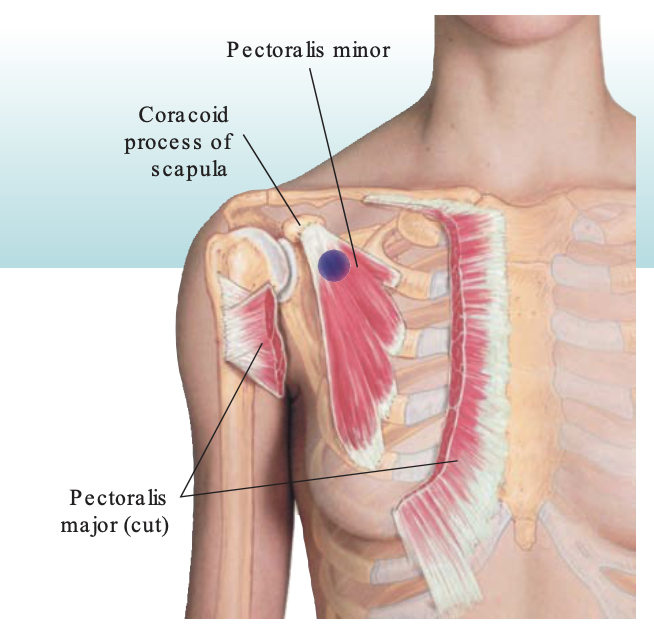Issue 11 Blue Crab Edition - Measuring Pecs and Whether PT Can Treat Chronic Elbow Tendinopathy

Can You Measure Pec Minor Length? It Seems So.
The Gist - This remarkably interesting study from PTJ digs into a new method to measure pec minor length. Why would you want to do that? Breast cancer. As it turns out, “decreased pec minor length is common after primary breast cancer treatment and can result in an abnormal position of the scapula.” You’ll know all the problems associated with that. The researchers dug into their toolbox to invent a new, cheap method of measuring pec minor length, since the old one need an MRI machine that most people don’t have laying around (and if you do, can I have it?).
They used something called a PALpation meter. It costs a couple hundred dollars and is apparently quite easy to use. It’s a combo of inclinometer and caliper designed to measure bodily distances. With it in hand, they checked the pec minor length of 29 women with previous breast cancer, measuring from origin to insertion. Since there’s no gold standard to compare with, they checked it against a motion capture system and the results were great! Intratester reliability was excellent, intertester was too, and the R value between PALM and motion capture was .87. So yay!
Why not use a tape measure? Breast areas are hard to measure, especially on women. This method let them measure a direct line without having to deal with bodily topography.
Tell Me More - Since we covered the why and how above, let’s talk a bit more about the stats here. According to the authors, this is the first study that uses inexpensive equipment get interrater reliability and validity for this measurement. On those stats, the researchers split out affected and unaffected sides, so I will too. On the affected side, standard error of measure was just 0.22cm, while is was 0.31cm on the affected side. Their mathematics after the fact showed that the minimum detectable change (MDC95) was 0.80cm. Overall, the measures tracked quite well with the motion capture system, making this an apparently good way to check pec minor length. If you’re interested in the whole thing, the study is short and quite detailed with more stats and info. Since it’s the PTJ, there’s no Open Access, but I did request a full-text through ResearchGate (that’s not back yet) and an APTA account will get you access to all of PTJ. Link below as usual.
Paper please. Here it is.
Can PT Treat Chronic Lateral Elbow Tendinopathy? It Seems Not.
The Gist - This complex one comes in the form of a systematic review from Physical Therapy Reviews (right to the point, aren’t they?). They look at all physical therapy interventions for chronic lateral elbow tendinopathy. They assessed the value of PT by looking into RCTs that used pain-free grip strength and/or patient rated tennis elbow evaluation questionnaires as outcome measures and the results weren’t fantastic.
22 RCTs met their eligibility criteria and boy were their approaches, timing, and outcome measures heterogenous. There’s a ton of data in this paper, so I’m just going to grab a few things. The 22 studies did very different things, from K Tape to manual therapy to eccentric strengthening. In general, no approach had a huge effect, but manual therapy and diamond taping did quite well. Specifically, myofascial release and mobilization with movement appeared to be a bit successful, most other methods were not.
Tell Me More - Honestly, I don’t love this review. I’m not the world’s foremost research expert, but I do read a ton of research and this one is on the messy end of the spectrum. It’s not their fault, the data they had to work with was messy as well. What the paper does very well is pull together many different RCTs about chronic lateral elbow tendinopathy and is a great resource for that research. The final takeaway from them is that PT is not an effective intervention for this condition, but some RCTs do say that some types of PT are effective and the authors specifically note that mobilization with movement and myofascial release show good short term benefits. We don’t yet have a good RCT of the long term benefits of these interventions. The review does stand on the back of other cited reviews that have shown similar results through the years, so this isn’t spurious research by any means. Altogether, this indicates that treatment for the condition is at least challenging and at worst ineffective. In any case, it must be done in a specific way to see results. Overall, I recommend you pop in and go through their table of studies to see which worked the best (though not on a computer because it’s annoyingly sideways. Use an iPad or some such). That’s where the good data lies that can point you in the right direction with your chronic lateral elbow tendinopathy patients.
So, where is that paper? Here. And I requested an open access one on ResearchGate as well. I’ll let you know if it’s shared there.
Featured image credit: Powellle, CC BY-SA 4.0 https://creativecommons.org/licenses/by-sa/4.0, via Wikimedia Commons
